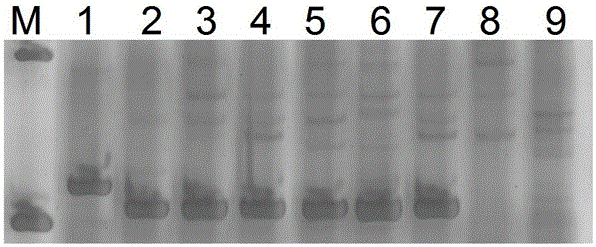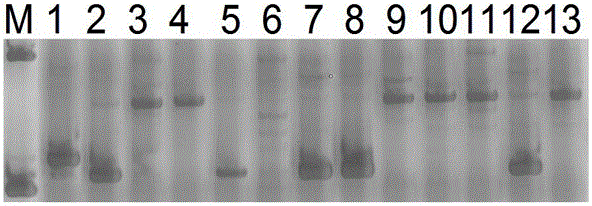Rice blast resistance gene Pi1 functional specificity molecular marker and application thereof
A resistance gene and molecular marker technology, applied in the field of agricultural biology, can solve problems such as being unsuitable for identification of germplasm resources or screening of resistance resources, unsuitable for large-scale resistance identification and MAS work, etc. volume and low cost
- Summary
- Abstract
- Description
- Claims
- Application Information
AI Technical Summary
Problems solved by technology
Method used
Image
Examples
Embodiment 1
[0032] Example 1: Rice blast resistance gene Pi1 Gene-specific molecular markers and their primer design and detection
[0033] (1) Analysis of Pi1 insertion / deletion (insertion-deletion, InDel) site:
[0034] Downloaded from public database Pi1 and Pik-m , Pik , Pik-p , Pik-s , Pi7 with Pik-h Partial genome sequences of rice donor varieties, sequenced varieties Nipponbare (Nipponbare) and 9311 have no corresponding genome sequences, sequence alignment and screening for the Pi1 site Pi1 A specific insertion / deletion (InDel) difference site that is specific and can be distinguished from other rice blast allelic resistance genes at this site. Rice blast resistance genetic variety IRBL1-CL with gene-specific InDel ( Pi1 ) and the resistant variety IRBLk-Ka ( Pik ), resistant variety IRBLkp-K60 ( Pik-p ), the resistant variety IRBLkm-Ts ( Pik-m ), resistant variety IRBLkh-K3 ( Pik-h ), the resistant variety IRBLks-S ( Pik-s ) and the resistant variety IRBL...
Embodiment 2
[0063] Embodiment 2: resistance gene Pi1 Gene-specific molecular markers in identifying Pik Application of different rice blast resistance genes in gene cluster regions.
[0064] According to the polymorphic PCR product bands, the target gene can be Pi1 with other Pik The resistance genes on the gene cluster were distinguished. Such as figure 1 As shown, depending on the stripe position, the Pi1 Distinguished from other resistance genes identified at this locus, 220 bp indicates that it contains Pi1 209 bp indicates other resistance genes that contain this site, and other bands indicate functional genes that do not contain this site. It can be seen that the test results are consistent with the design analysis, indicating that the resistance gene Pi1 Gene-specific molecular markers can be identified in Pi1 gene and Pik Gene family alleles and other aspects have been applied.
Embodiment 3
[0065] Embodiment 3: resistance gene Pi1 Detection application of gene-specific molecular markers in other rice varieties
[0066] Select 12 representative rice varieties, in order: Zhenshan 97B, Co39, Fuhui 838, Gufeng B, Jinnante 43B, Nante, Anfeng B, Teqing 2, Baoxie 123B, Nanjing 11 , Zhuzhen B, Bantam Nantes.
[0067] Genomic DNA was extracted respectively, and using this as a template, PCR amplification, enzyme digestion and electrophoresis detection were performed according to the method of Example 1. According to the size of the digested product (band), the resistance gene can be Pi1 Distinguished from other rice blast resistance genes. Such as figure 2 As shown, the resistance spectrum phenotype is Pi1 Type individuals (carrying rice blast resistance gene Pi1 The presence of Pi1-InDel gene-specific molecular markers can be detected in the disease-resistant variety IRBL1-CL (samples in lane 1), while the molecular markers cannot be detected in individuals with o...
PUM
 Login to View More
Login to View More Abstract
Description
Claims
Application Information
 Login to View More
Login to View More - R&D
- Intellectual Property
- Life Sciences
- Materials
- Tech Scout
- Unparalleled Data Quality
- Higher Quality Content
- 60% Fewer Hallucinations
Browse by: Latest US Patents, China's latest patents, Technical Efficacy Thesaurus, Application Domain, Technology Topic, Popular Technical Reports.
© 2025 PatSnap. All rights reserved.Legal|Privacy policy|Modern Slavery Act Transparency Statement|Sitemap|About US| Contact US: help@patsnap.com



